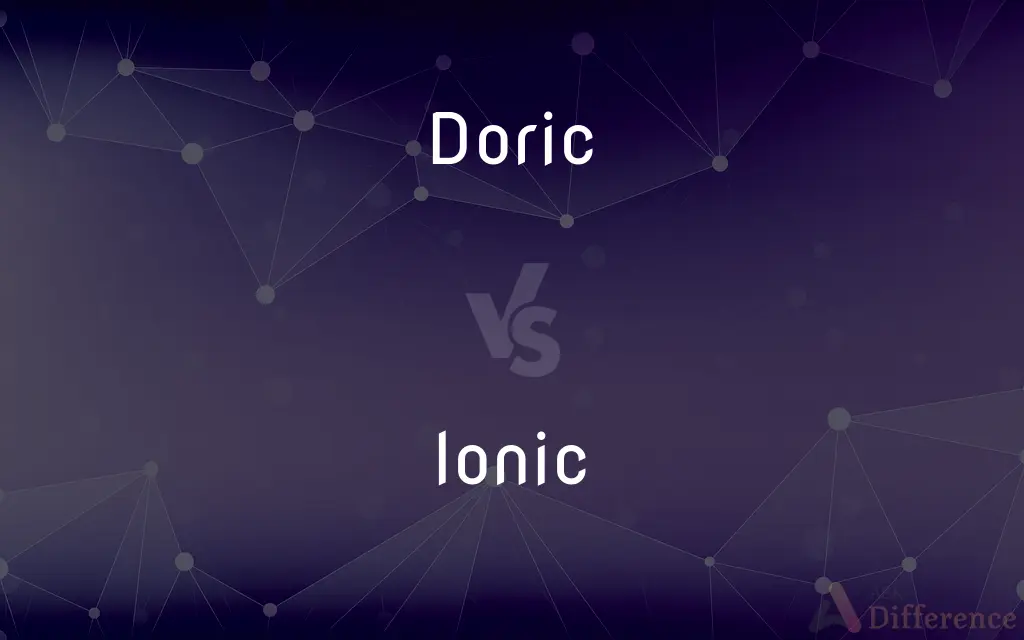Doric vs. Ionic — What's the Difference?
Edited by Tayyaba Rehman — By Fiza Rafique — Updated on October 5, 2023
Doric and Ionic are classical architectural orders; Doric is characterized by sturdy columns and a simple capital, while Ionic features slender columns and a scrolled capital.

Difference Between Doric and Ionic
Table of Contents
ADVERTISEMENT
Key Differences
Doric and Ionic are two of the classical orders of ancient Greek architecture. The Doric order is known for its solid, robust columns and relatively plain capital. In contrast, the Ionic order is recognized for its more elegant, slender columns crowned with a capital that often resembles a scroll.
The Doric style primarily originated in mainland Greece and was the older and more simplistic of the two. The Ionic style, on the other hand, developed in eastern Greece, in regions like Ionia, boasting a more decorative and refined appearance.
Doric columns are typically fluted with 20 concave grooves and stand directly on the floor without a base. Ionic columns, however, usually have 24 flutes and rest on a base. The distinction between their capitals is also evident; Doric has a rounded section called echinus, while Ionic features a scroll-like design called a volute.
Doric columns are generally shorter and sturdier, with a height-to-base ratio of around 4:1 to 8:1. Ionic columns present a more slender profile with a typical height-to-base ratio of 9:1 or more, making them appear taller and more graceful.
While both orders were used in various structures, Doric columns were frequently seen in temples dedicated to male gods due to their "masculine" appearance. Ionic columns, with their "feminine" elegance, often adorned temples dedicated to goddesses and other structures in the eastern Greek islands.
ADVERTISEMENT
Comparison Chart
Origin
Mainland Greece.
Eastern Greece (Ionia).
Column Profile
Sturdy, shorter columns.
Slender, taller columns.
Column Details
20 flutes, no base, simple capital.
24 flutes, base present, scrolled capital.
Height-to-Base Ratio
Roughly 4:1 to 8:1.
Usually 9:1 or more.
Typical Architectural Associations
Temples for male gods.
Temples for goddesses, structures in eastern Greek islands.
Compare with Definitions
Doric
Pertaining to a classical architectural order characterized by sturdy columns.
The Parthenon in Athens showcases the Doric style.
Ionic
Columns typically resting on a base.
Unlike Doric, Ionic columns have a distinct base beneath them.
Doric
Representing a more "masculine" aesthetic in Greek architecture.
Temples for male gods often featured Doric designs.
Ionic
Originated in eastern Greece, especially Ionia.
The Ionic style has its roots in the eastern regions of Greece.
Doric
Featuring a simple, rounded capital atop columns.
Doric capitals lack the intricate detailing seen in some other styles.
Ionic
Relating to or denoting a classical order of architecture characterized by a column with scroll shapes (volutes) on either side of the capital.
Doric
Often without a base, standing directly on the floor.
The Doric columns' absence of a base gives them a grounded appearance.
Ionic
Another term for Ionian
Doric
Relating to or denoting a classical order of architecture characterized by a sturdy fluted column and a thick square abacus resting on a rounded moulding.
Ionic
The Ionic order of architecture.
Doric
Relating to the ancient Greek dialect of the Dorians.
Ionic
The ancient Greek dialect used in Ionia.
Doric
The Doric order of architecture.
Ionic
Of or relating to Ionia or the Ionians.
Doric
The ancient Greek dialect of the Dorians.
Ionic
(Architecture) Of or relating to the Ionic order.
Doric
A dialect of ancient Greek spoken in the Peloponnesus, Crete, certain of the Aegean Islands, Sicily, and southern Italy.
Ionic
Of, containing, or involving ions.
Doric
Of, relating to, characteristic of, or designating Doric.
Ionic
The ancient Greek dialect of Ionia.
Doric
(Architecture) Of or relating to the Doric order.
Ionic
(chemistry) of, relating to, or containing ions
Doric
Pertaining to Doris, in ancient Greece, or to the Dorians; as, the Doric dialect.
Ionic
Of or pertaining to Ionia or the Ionians.
Doric
Belonging to, or resembling, the oldest and simplest of the three orders of architecture used by the Greeks, but ranked as second of the five orders adopted by the Romans. See Abacus, Capital, Order.
Ionic
Pertaining to the Ionic order of architecture, one of the three orders invented by the Greeks, and one of the five recognized by the Italian writers of the sixteenth century. Its distinguishing feature is a capital with spiral volutes. See Illust. of Capital.
Doric
Of or relating to one of the ancient Greek musical modes or keys. Its character was adapted both to religions occasions and to war.
Ionic
Of or pertaining to ions; composed of ions, containing ions, or breaking down into ions when dissolved in a polar solvent; as, an ionic solution will conduct a current of electricity. Opposite of nonionic.
Doric
The Doric dialect.
Ionic
A foot consisting of four syllables: either two long and two short, - that is, a spondee and a pyrrhic, in which case it is called the greater Ionic; or two short and two long, - that is, a pyrrhic and a spondee, in which case it is called the smaller Ionic.
Doric
The dialect of Ancient Greek spoken in the Peloponnesus
Ionic
The Ionic dialect; as, the Homeric Ionic.
Doric
An order of classical Greek architecture
Ionic
Ionic type.
Doric
Originating primarily from mainland Greece.
Doric architecture is rooted in the traditions of mainland Greece.
Ionic
The dialect of Ancient Greek spoken in Ionia
Ionic
Containing or involving or occurring in the form of ions;
Ionic charge
Ionic crystals
Ionic hydrogen
Ionic
Oldest and simplest of the three orders of classical Greek architecture
Ionic
Relating to a classical architectural style with slender columns.
The Temple of Athena Nike exhibits the Ionic order.
Ionic
Showcasing a scrolled or volute capital design.
Ionic capitals are easily identifiable by their unique scrolled design.
Ionic
Embodying a "feminine" elegance in its designs.
Temples dedicated to goddesses often embraced the Ionic style.
Common Curiosities
Are Ionic columns typically taller than Doric columns?
Yes, Ionic columns are generally taller and more slender, presenting a graceful profile.
Where did the Doric style mainly originate?
Doric primarily originated in mainland Greece.
Which architectural style, Doric or Ionic, has columns with a base?
Ionic columns typically rest on a base, while Doric columns often stand directly on the floor without a base.
Which architectural order, Doric or Ionic, is older?
Doric is the older of the two architectural styles.
Which order, Doric or Ionic, features a scroll-like capital?
The Ionic order showcases a scrolled or volute design on its capital.
Are there temples that combine both Doric and Ionic elements?
Yes, some structures, like the Erechtheion in Athens, blend elements from both orders.
Are Doric columns generally thicker than Ionic ones?
Yes, Doric columns are typically sturdier and shorter than the slender Ionic columns.
Is the Doric style considered more "masculine" than the Ionic style?
Yes, the Doric style is often described as more "masculine," while the Ionic style is considered "feminine."
Which region popularized the Ionic style?
The Ionic style was popularized in eastern Greece, particularly in Ionia.
Which order is more decorative, Doric or Ionic?
Ionic is generally considered more decorative and refined compared to the simpler Doric order.
What's a defining feature of Ionic capitals?
Ionic capitals are characterized by their scroll-like design, known as volutes.
How many flutes do typical Doric columns have?
Doric columns usually have 20 flutes.
Did Roman architecture adopt Doric and Ionic styles?
Yes, the Romans adopted and adapted both Doric and Ionic styles, incorporating them into their architecture.
Where can one see authentic examples of Doric and Ionic architecture?
Ancient Greek temples, like the Parthenon (Doric) and the Temple of Athena Nike (Ionic), are classic examples of these styles.
How do you identify a Doric capital?
A Doric capital is relatively simple and rounded, often described as "plain."
Share Your Discovery

Previous Comparison
Apprehension vs. Comprehension
Next Comparison
Hyphen vs. DashAuthor Spotlight
Written by
Fiza RafiqueFiza Rafique is a skilled content writer at AskDifference.com, where she meticulously refines and enhances written pieces. Drawing from her vast editorial expertise, Fiza ensures clarity, accuracy, and precision in every article. Passionate about language, she continually seeks to elevate the quality of content for readers worldwide.
Edited by
Tayyaba RehmanTayyaba Rehman is a distinguished writer, currently serving as a primary contributor to askdifference.com. As a researcher in semantics and etymology, Tayyaba's passion for the complexity of languages and their distinctions has found a perfect home on the platform. Tayyaba delves into the intricacies of language, distinguishing between commonly confused words and phrases, thereby providing clarity for readers worldwide.














































